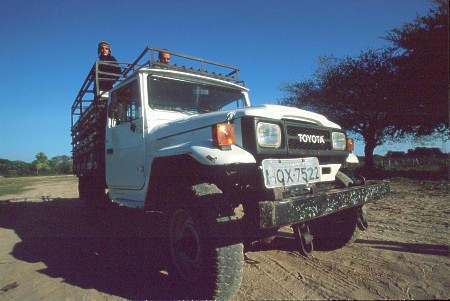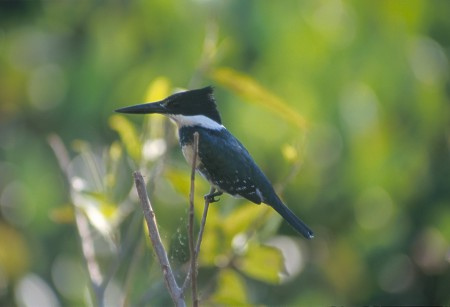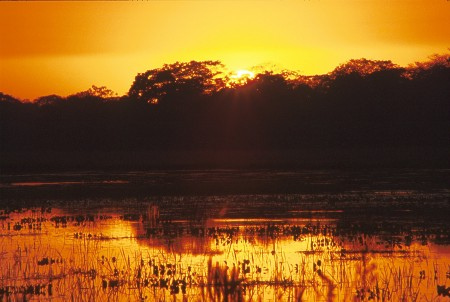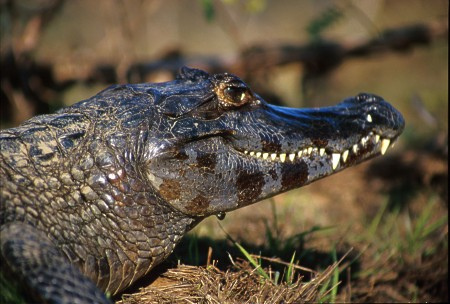Pantanal Adventure
The Pantanal is a paradise for adventurers. This was true in the past, when the region was a remote frontier for competing Empires, and playground for the British explorer who reputedly provided the template for Indiana Jones. Today's visitors can also find adventure with activities such as those below.
Your "safari" in the Pantanal can take many forms. It could be a jeep ride, a horse ride, or even just simple guided trek the wetlands, grass and forest. Each to these has its advantages.
Jeep Safaris
These help you cover the most ground in the shortest time. These generally take you along along dirt roads and farm tracks - since Pantanal roads being an unexpectedly popular gathering place for wildlife. This is because:
- many roads are built above the water level - becoming a dry sanctuary in the wet season - whereas;
- pools and ditches along the side of the road often hold some of the last water during the dry season - providing a refuge for jacarés and capybaras.
When animals see a vehicle coming, they'll generally try to scamper (or slither) off the road surface quickly, headed for the comparative safety of the nearby undergrowth. For this reason, the jeep driver will usually stop the vehicle as soon as the animal is seen, with the guide jumping out of the vehicle to capture or cut off the animal's exit if possible (and keeping a spotlight on the animal if its a night safari. At this point the jeep passengers also exit the jeep to get a closer look, take photos, and to learn a little more about the animal from the guide before it gets released.
Horse Treks
Doing your wildlife safari on horseback is another classic Pantanal experience. This usually takes the form of a slow guided trek on local Pantaneiro breed horses. The horses may appear small and visually unimpressive - but their sure-footedness moving through the flooded landscape is a god-send, and will take you through swamps and other places where four-wheel drives can't (easily) go. But, be prepared to get a little wet as sometimes the water can be deep.
One advantage of traveling on horseback is that, when they see the horse, most wildlife will perceive it simply as another animal and will ignore the rider on its back.
Wildlife Treks
Walking tours and treks are one of the best opportunities to see wildlife - but be prepared to get wet and muddy. It's also not a great idea to wear your best trekking shoes. Since you're likely be trekking through water then sandals are the best idea. Also take mosquito repellent since, once you get into the forest you'll probably find yourself being attacked by a swarm of midges.
The advantage of a walking tour is that this this can take you in much closer to wildlife, exploring nests, looking at insects, plants, and all the other small things that you'd probably miss from the back of a jeep or a horse. It also removes constraints such as fences, which you can easily climb over. Walking tours are also a great opportunity for photography - although serious photographers will find that they need to whittle their gear down to just the essentials which are comfortable enough to carry.
Boat Treks
This is another great option as much of the Pantanal's wildlife congregate along the riverbanks. Small boats are probably the best option for photographers as the boat is a practical means for carrying all your gear, gives you an almost-stable platform, and a great opportunity to get good eye-level shots of animals such as jacaré and (if you're really lucky) jaguar. Most boats will have a noisy outboard motor - but this can be switched off once animals come into view. This leaves you to drift quietly and without disturbing the wildlife.
Watch out. This will occasionally let you get much closer than expected.
Jacaré image taken by a photographer leaning in the nose of a boat as it drifted towards the riverbank. This lets you get close - but be careful of getting too close. Shortlly after this image was taken, the view through the camera lens got blurry - as the photographer had drifted within the minimum focusing distance (about two feet). Dropping your camera and realising you're close enough to kiss a jacaré is an unnerving experience, and ideally avoided.








Banner image: Tourists on a Pantanal Horse Trek(Shutterstock/Filipe Matos Frazao)
Footer images: (Andrew Mercer)

Pantanal Escapes